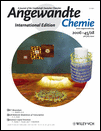Communication
Very High Rate Enhancement of Benzyl Alcohol Oxidation by an Artificial Enzyme†
Lavinia G. Marinescu Dr.,
Mikael Bols Prof. Dr.,
Lavinia G. Marinescu Dr.
Department of Chemistry, University of Aarhus, 8000 Aarhus, Denmark, Fax: (+45) 8619-6199
Search for more papers by this authorMikael Bols Prof. Dr.
Department of Chemistry, University of Aarhus, 8000 Aarhus, Denmark, Fax: (+45) 8619-6199
Search for more papers by this authorLavinia G. Marinescu Dr.,
Mikael Bols Prof. Dr.,
Lavinia G. Marinescu Dr.
Department of Chemistry, University of Aarhus, 8000 Aarhus, Denmark, Fax: (+45) 8619-6199
Search for more papers by this authorMikael Bols Prof. Dr.
Department of Chemistry, University of Aarhus, 8000 Aarhus, Denmark, Fax: (+45) 8619-6199
Search for more papers by this author†
We thank the Lundbeck foundation and the SNF(FNU) for support.
Graphical Abstract
References
- 1A. J. Kirby, Angew. Chem. 1996, 108, 770–790;
10.1002/ange.19961080705 Google ScholarAngew. Chem. Int. Ed. Engl. 1996, 35, 706–724.
- 2R. Breslow, S. D. Dong, Chem. Rev. 1998, 98, 1997–2012.
- 3E. E. Karakhanov, A. L. Maksimov, E. A. Runova, Y. S. Kardasheva, M. V. Terenina, T. S. Buchneva, A. Y. Guchkova, Macromol. Symp. 2003, 204, 159–173.
- 4S. Sasaki, K. Koga, Stud. Org. Chem. 1992, 45, 265–310.
- 5W. B. Motherwell, M. J. Bingham, Y. Six, Tetrahedron 2001, 57, 4663–4686.
- 6R. Breslow, Science 1982, 218, 532–537.
- 7For some recent examples, see:
- 7aM. J. Han, S. K. Yoo, J. Y. Chang, T.-K. Ha, Angew. Chem. 2000, 112, 355–357;
Angew. Chem. Int. Ed. 2000, 39, 347–349;
10.1002/(SICI)1521-3773(20000117)39:2<347::AID-ANIE347>3.0.CO;2-Q CAS PubMed Web of Science® Google Scholar
- 7bR. Breslow, X. Zhang, Y. Huang, J. Am. Chem. Soc. 1997, 119, 4535–4536;
- 7cM. Kunishima, K. Yoshimura, H. Morigaki, R. Kawamata, K. Terao, S. Tani, J. Am. Chem. Soc. 2001, 123, 10760–10761;
- 7dS. H. Yoo, B. J. Lee, H. Kim, J. Suh, J. Am. Chem. Soc. 2005, 127, 9593–9602;
- 7eL. Jiang, Z. L. Liu, Z. Liang, Y. Gao, Bioorg. Med. Chem. 2005, 13, 3673–3680;
- 7fN. M. Milovic, J. D. Badjic, N. M. Kostic, J. Am. Chem. Soc. 2004, 126, 696–697.
- 8High rate acceleration has however been observed in the transacylation of cyclodextrins at high pH, see: G. L. Trainer, R. Breslow, J. Am. Chem. Soc. 1981, 103, 154–158.
- 9A. J. Pearce, P. Sinaÿ, Angew. Chem. 2000, 39, 3610–3611;
10.1002/1521-3773(20001016)39:20<3610::AID-ANIE3610>3.0.CO;2-V CAS PubMed Web of Science® Google ScholarAngew. Chem. Int. Ed. 2000, 39, 3610–3611.10.1002/1521-3773(20001016)39:20<3610::AID-ANIE3610>3.0.CO;2-V CAS PubMed Web of Science® Google Scholar
- 10C. Rousseau, B. Christensen, M. Bols, Eur. J. Org. Chem. 2005, 2734–2739.
- 11L. Marinescu, M. Mølbach, C. Rousseau, M. Bols, J. Am. Chem. Soc. 2005, 127, 17578–17579.
- 12R. Wolfenden, M. J. Snider, Acc. Chem. Res. 2001, 34, 938–945.
- 13A plot of kcat/Km vs. σ (not shown) gave a poorer correlation (r2=0.55) and 1.2 as ρ.
- 14S. E. Jacobson, D. A. Muccigrosso, F. Mares, J. Org. Chem. 1979, 44, 921–924.
- 15Ruthenium- and palladium-catalyzed oxidation of benzylic alcohols gives reaction constants that are small and negative (ρ≈−0.5; see:
- 15aA. Dijksman, A. Marino-Gonzalez, A. Mairata I Payeras, I. W. C. E. Arends, R. A. Sheldon, J. Am. Chem. Soc. 2001, 123, 6826–6833;
- 15bJ. A. Mueller, C. P. Goller, M. S. Sigman, J. Am. Chem. Soc. 2004, 126, 9724–9734). As the present reaction does not involve formation of a positively charged metal center, its high ρ value is not surprising.
- 16The following extinction coefficients ε [mM−1 cm−1] (25 °C, pH 7) and wavelengths λ [nm] of the products were determined and used: benzaldehyde (1.23, 285), acetophenone (0.32, 300), benzophenone (4.03, 280), 2-hydroxybenzaldehyde (2.92, 325), 2-methoxybenzaldehyde (2.75, 323), 2-chlorobenzaldehyde (1.24, 300), 2-bromobenzaldehyde (0.47, 292), 3-methoxybenzaldehyde (2.48, 313), 4-methoxybenzaldehyde (7.53, 300), 4-hydroxybenzaldehyde (6.1, 329), 4-fluorobenzaldehyde (0.88, 292), 4-chlorobenzaldehyde (1.09, 286), 4-bromobenzaldehyde (1.59, 295), 4-methylbenzaldehyde (3.37, 285), 2,6-dimethoxybenzaldehyde (3.63, 323), 2,6-dichlorobenzaldehyde (1.03, 309), acetylferrocene (1.68, 345 nm).





